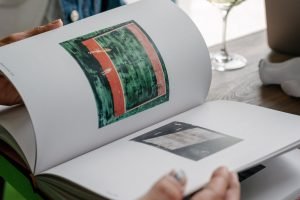Introduction to the work of ANDREA BARZAGHI 2009 - 2022
Sunday 29 May 2022 – 5 pm
Andrea Barzaghi’s daily practice is punctuated by the passing presence of pictorial moments that converge in two phases: that of the ‘white winter’ (a dry and rarefied painting) and the ‘green winter’ (where the colours become fuller and milder, like those of spring and summer, when nature awakens despite the still sharp air). Wild, rugged nature, with its green tones, towering trees, flowering bushes, small ravines, trunks of trees that have died of old age or have been felled… In these green winters, I see the whole series of flowering fields1 and forests2 which will then – chronologically – turn more and more towards tropical contaminations and the presence of silhouettes3, figures, humanoids4 and finally men hiding5 and wandering6 through a dense, flat natural expanse. White winters are the collective ascents into a dilated space7 (Giudizio), the membranes between worlds8 (Teil I, Teil II) but also windows on a black space9 (Arco e Abbiegung). This is how the seasons are usually described in the Nordic lands, and this is how – after almost ten years of following Andrea Barzaghi – I like to imagine his pictorial approach.
His is an honest painting, not one hidden behind conceptual sleights of hand, not ashamed of being instinctive, citational, sometimes simple and sometimes so synthetic as to be almost difficult to interpret. At times he may seem naïve, but his recent past reveals a link to traditions (those of Urbino, of Nuremberg), their assimilation and surpassing, reaching a formal synthesis where the paintings are sincerely and freely simplified. He is honest in the full range of his modus operandi: it is not just paint and canvas but an extension and mixing of the former, while the line of his drawing and the structure of the installations have all the same dignity as painting. Hence, no longer just canvas but also paper, wall, chipboard, yielding both two- and three-dimensional works. And last but not least, not only brush but also pencil, pastel, oil and acrylic, cut-outs, collages, outlines and cancellation, layering and joining.

BOOK LAUNCH. INTRODUZIONE ALL’OPERA DI ANDREA BARZAGHI.
Barzaghi’s artistic research follows a sinusoidal spiral pattern that blends the present, past and future; it is not a static line that repeats itself but a continuous evolution of the themes and manners of painting most dear to him. A painting that is at times coarse and contaminated by his past reminiscences and encounters, interspersed with the cadence (the need) of the most extreme research. It is a continuous path that folds back onto itself yet with the aim of evolving each time, constantly questioning itself, finding contradiction in its practice and attempting to surpass itself each time. Barzaghi’s is a courageous kind of painting, one which only today no longer frightens me but which continues to amaze me, making me fall in love each time, forever enriched with that extra element that both disturbs and amazes me.
Stefania Margiacchi (Montevarchi 1990) is an independent curator and gallerist, pursuing her own artistic research in Turin.
In 2018 she founded the Société Interludio with artist Paul de Flers.
From 2017 to 2021, Stefania Margiacchi was artistic director of Spaziosiena: a contemporary art centre and cultural space just a few steps from Piazza del Campo in Siena.
As an independent curator, Margiacchi has also overseen several projects for the municipality of Siena. One of these was the first street art festival: in 2016 (A)Round TU35_Siena | Street_View was presented to the city.
That same year, together with her father, Margiacchi organised a programme of artists’ residencies in Fortaleza (Brazil) for young European artists.
In 2015 she won the call for Tuscan curators under 35 organised by the Luigi Pecci Centre for Contemporary Art in Prato. On the strength of this, she organised the group exhibition Guardarsi Intorno, with the contribution of curator Lorenzo Bruni. A few months later, she was invited by the director herself of the Children’s Museum of Siena – in the Santa Maria della Scala Museum Complex – to present the exhibition during the contemporary art week, where, she had served as assistant curator in previous years.
by Stefania Margiacchi








